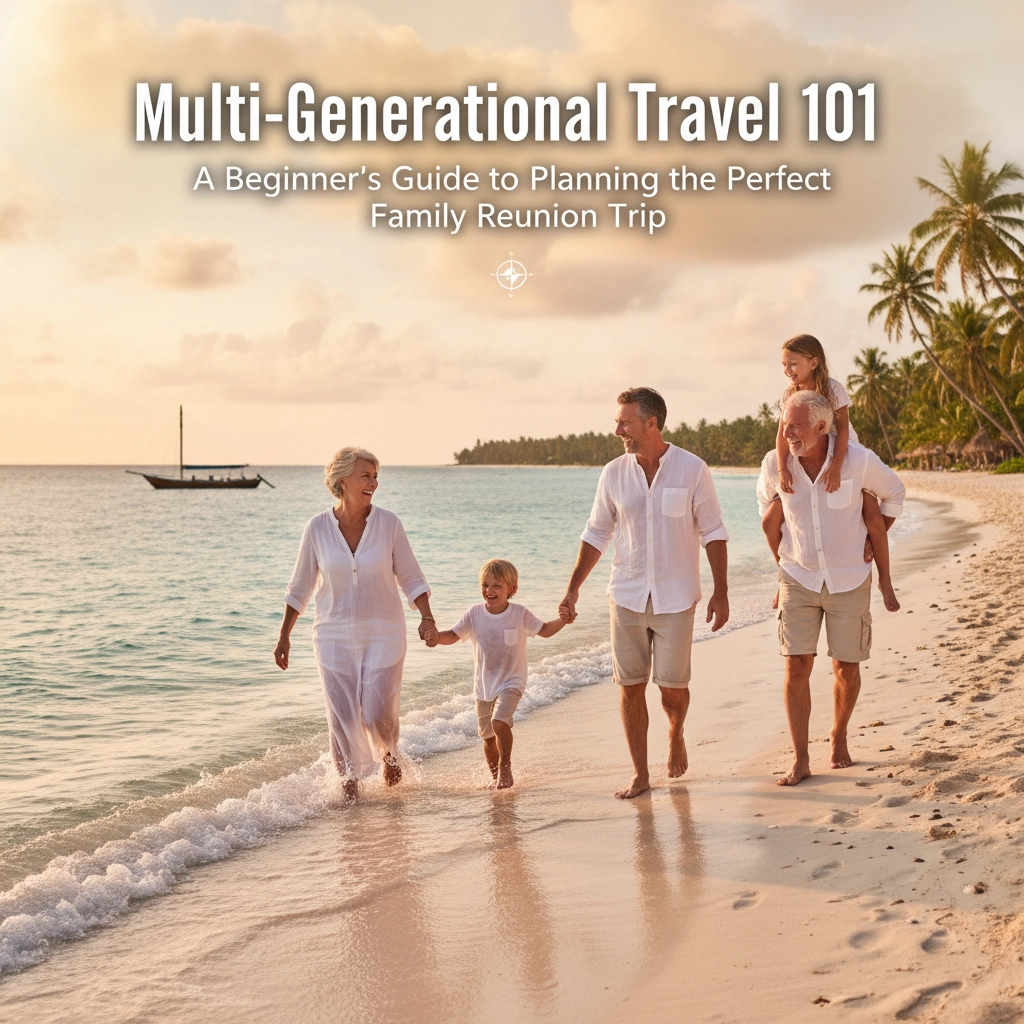 Planning a family vacation that keeps everyone happy, from toddlers to great-grandparents, might seem like an impossible puzzle. But here’s the thing: multi-generational travel is having a major moment right now, and for good reason. After years of being separated by distance, busy schedules, and recent world events, families are craving those precious shared experiences more than ever.
Planning a family vacation that keeps everyone happy, from toddlers to great-grandparents, might seem like an impossible puzzle. But here’s the thing: multi-generational travel is having a major moment right now, and for good reason. After years of being separated by distance, busy schedules, and recent world events, families are craving those precious shared experiences more than ever.
As someone who’s helped countless families navigate these complex trip dynamics over the years, I can tell you that the secret isn’t finding the “perfect” destination that magically pleases everyone. It’s about smart planning, clear communication, and setting realistic expectations from the get-go.
Why Multi-Generational Travel Is Worth the Effort
Before we dive into the how-to, let’s talk about the why. Multi-generational trips offer something truly special, the chance for different generations to see each other in new environments, share experiences, and create memories that’ll be talked about at family gatherings for years to come. Kids get to see their grandparents as adventurous travel companions, not just cookie-baking fixtures in the living room. Adults get help with childcare duties while still enjoying vacation time. And grandparents? They get quality time with grandkids without the daily parenting pressure.
Plus, let’s be practical here, splitting costs across multiple family units can make destinations and accommodations possible that might be out of reach for individual families.
Start Planning Early (Like, Really Early)
Here’s your first golden rule: start planning at least six months ahead, preferably longer. I know that sounds excessive, but trust me on this one. You’re not just coordinating one family’s schedule: you’re juggling multiple households, school calendars, work commitments, and possibly medical appointments.
Early planning also means better deals and more options. Popular family-friendly destinations and large vacation rentals get booked up fast, especially during school breaks. Starting early gives you the luxury of choice rather than settling for whatever’s left.

Understanding Everyone’s Needs and Limitations
This is where things get real. Every family member brings different needs, abilities, and preferences to the table. Grandma might need ground-floor accommodations and accessible bathrooms. Your teenagers might roll their eyes at anything that seems too “family-friendly.” The toddlers need nap schedules respected, and Uncle Bob insists on having his morning coffee routine undisturbed.
Take time upfront to have honest conversations with each family unit about their must-haves, deal-breakers, and wishlist items. Create a simple survey or family meeting where everyone can voice their thoughts. You’ll thank yourself later when you’re not dealing with disappointed family members mid-vacation.
Choosing Your Destination Wisely
For your first multi-generational adventure, stick with single-destination trips. Trying to hop between multiple cities or countries with a large group is a logistical nightmare you don’t need. Instead, look for destinations that offer variety within one location.
Some of my go-to recommendations for families include:
The Great Smoky Mountains offer something for everyone: stunning nature for the outdoor enthusiasts, cultural attractions like Dollywood, and relaxed mountain towns perfect for slower-paced exploration.
Orlando isn’t just about Disney (though that’s certainly an option). The area has world-class theme parks, beautiful resorts, and activities ranging from high-energy adventures to peaceful nature preserves.
Beach destinations like Myrtle Beach or Gulf Shores provide the perfect backdrop for multi-generational fun. Beach days can be as active or relaxed as each family member wants, and there are always indoor backup activities when weather doesn’t cooperate.
The key is choosing places with natural beauty and diverse activity options. You want destinations where the adventure-seekers can find their thrills while the relaxation-focused family members can find their peace.
Accommodation Strategy: Bigger Is Better
Forget booking multiple hotel rooms. For multi-generational trips, vacation rentals are your best friend. Look for large homes or villas with multiple bedrooms, plenty of bathrooms, and most importantly: communal spaces where everyone can gather.
A full kitchen is non-negotiable. Being able to prepare some meals at “home” saves money, accommodates dietary restrictions, and gives you flexibility with meal times. Plus, there’s something special about multi-generational cooking sessions where grandparents can share family recipes with the kids.
Make sure your rental has outdoor space if possible. Patios, decks, or yards give active kids room to burn energy while adults can supervise from comfortable seating areas.

The Money Talk: Get It Out of the Way Early
Nobody likes talking about money, but avoiding this conversation is vacation-trip suicide. Before anyone books anything, establish crystal-clear expectations about who pays for what.
Some families have one person (often the grandparents) cover major expenses like accommodations and transportation. Others split everything equally among families. Some use a sliding scale based on household income. There’s no right or wrong approach: just whatever works for your family dynamic.
The important thing is having this conversation early and sticking to the agreement. Nothing ruins family bonding faster than surprise expenses or resentment over unequal contributions.
Activity Planning: Balance Is Everything
Here’s where many well-intentioned planners go wrong: they try to pack every moment with scheduled activities. Don’t do this. Plan one major activity per day, leaving plenty of room for rest, spontaneous exploration, and simple together time.
Think about creating natural activity groupings. Maybe the teenagers and active adults tackle the adventure park while grandparents and younger kids enjoy a more leisurely museum visit. Then everyone reunites for dinner and stories about their day.
Build in downtime deliberately. Some of the best family memories happen during unscheduled moments: kids playing in the pool while adults chat on the deck, impromptu ice cream runs, or quiet evening conversations on the porch.
Setting Realistic Expectations
Multi-generational travel isn’t about creating picture-perfect moments for social media. It’s about connection, and connection can be messy. Kids will have meltdowns. Adults will get tired and cranky. Plans will need to change.
The families who enjoy their trips most are the ones who stay flexible and supportive of each other. When the two-year-old has a breakdown in the restaurant, don’t stress about it ruining everyone’s meal. When grandpa needs to skip the afternoon activity because he’s tired, help him feel comfortable about it rather than guilty.

Communication Throughout the Process
Create a group chat or shared document where everyone can stay updated on plans, ask questions, and share excitement about the upcoming trip. This keeps everyone in the loop and prevents that game of telephone where information gets lost or distorted.
For grandparents traveling with adult children and grandchildren, this is especially important: follow your adult children’s lead when it comes to their family’s routines and rules. Support their parenting decisions, especially around discipline and bedtimes, even if you might handle things differently.
Practical Planning Tips
Pack thoughtfully for everyone’s needs. Create shared packing lists so nothing crucial gets forgotten. Consider bringing items that cater to different ages: games for rainy days, comfortable walking shoes for everyone, and any special medications or supplies.
Build buffer time into your travel days. Large groups move slower than individuals or couples. What normally takes 30 minutes might take an hour with multiple generations in tow.
Have backup plans for weather or unexpected changes. Indoor activities, alternative restaurants, and flexible transportation options can save the day when original plans fall through.
When to Consider Professional Help
Planning a small to medium-sized family reunion (up to about 15-20 people) is definitely manageable on your own with good organization and communication. But for very large gatherings or complex international trips, working with experienced travel professionals can save your sanity and ensure everyone has the best possible experience.
As someone who’s been helping families create these special memories since 2017, I’ve seen firsthand how the right planning approach can transform a potentially stressful experience into something truly magical. Whether you’re planning your first multi-generational adventure or looking to improve on past trips, the key is starting with clear communication, realistic expectations, and plenty of flexibility for the unexpected moments that often become the most treasured memories.
Multi-generational travel isn’t just about the destination: it’s about the connections you strengthen and the new perspectives you gain by experiencing the world alongside the people you love most. With thoughtful planning and realistic expectations, your family reunion trip can become the foundation for years of future adventures together.
Ready to start planning your perfect family reunion trip? I’d love to help you navigate all the details and create an unforgettable experience for every generation in your family. Fill out my trip planning form and let’s start turning your multi-generational travel dreams into reality.
